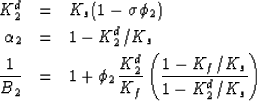To make numerical predictions of attenuation and dispersion, models must be proposed for the phase 2 (porous grain) parameters.
If the grains are modeled as spheres of radius R, the fluid-pressure gradient length
within the grains can be estimated as ![]() and the volume to
surface ratio as V/S = R/(3v2). The grain porosity is assumed to
be in the form of microcracks and so it is natural to define an effective aperature
h for these cracks. If the cracks have an average effective radius of R/NR where NR
is roughly 2 or 3 and if there are on average Nc cracks per grain
where Nc is also roughly 2 or 3 then the permeability and porsity of the grains
is reasonably modeled as
and the volume to
surface ratio as V/S = R/(3v2). The grain porosity is assumed to
be in the form of microcracks and so it is natural to define an effective aperature
h for these cracks. If the cracks have an average effective radius of R/NR where NR
is roughly 2 or 3 and if there are on average Nc cracks per grain
where Nc is also roughly 2 or 3 then the permeability and porsity of the grains
is reasonably modeled as
| (127) |
| (128) |
The drained grain modulus Kd2 is necessarily
a function of the crack porosity ![]() (and therefore h/R).
Real crack surfaces have
micron (and smaller) scale asperities present upon them.
If effective stress is applied in order
to make the normalized aperature h/R smaller (so that, for example,
the peak in squirt attenuation
lies in the seismic band), new contacts are created that
make the crack stronger. In the limit as
(and therefore h/R).
Real crack surfaces have
micron (and smaller) scale asperities present upon them.
If effective stress is applied in order
to make the normalized aperature h/R smaller (so that, for example,
the peak in squirt attenuation
lies in the seismic band), new contacts are created that
make the crack stronger. In the limit as ![]() (large effective stress),
the cracks are no longer present and
(large effective stress),
the cracks are no longer present and ![]() where Ks is the mineral modulus of the grain.
where Ks is the mineral modulus of the grain.
Many models for such stiffening could be proposed.
We intentionally make a conservative estimate here in proposing a simple
linear porosity dependence
![]() ,where
,where ![]() is a fixed constant determined from
fitting ultrasonic attenuation data. Effective medium theories
[see, for example, Berryman et al. (2002)] predict
that
is a fixed constant determined from
fitting ultrasonic attenuation data. Effective medium theories
[see, for example, Berryman et al. (2002)] predict
that ![]() should be inversely proportional to the aspect ratios of
the cracks present.
As a crack closes and asperities are brought into contact, there is
naturally a decrease in
should be inversely proportional to the aspect ratios of
the cracks present.
As a crack closes and asperities are brought into contact, there is
naturally a decrease in ![]() but there should also be a decrease in
but there should also be a decrease in ![]() due to the
fact that the remaining crack porosity becomes more spherical as new
asperities come into contact.
Taking
due to the
fact that the remaining crack porosity becomes more spherical as new
asperities come into contact.
Taking ![]() to be constant as crack porosity decreases
is thus a minimalist estimate for how the drained modulus increases.
to be constant as crack porosity decreases
is thus a minimalist estimate for how the drained modulus increases.
Thus, the porous-grain elastic properties are taken to be
 |
(129) | |
| (130) | ||
| (131) |
| (132) |